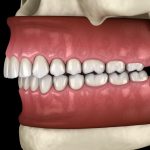There are several types of dental malocclusions. In order to distinguish between them, they are grouped into three categories: class 1, class 2 and class 3.
In this article, find out about class 3 malocclusion and the types of treatments that can be used to correct it.
Definition of a class 3 malocclusion
Dental malocclusions are classified based on the positioning of the upper and lower molars. Class 3 is the rarest type of malocclusion.
Contrary to class 2, class 3 malocclusions are characterized by lower molars that are too far forward compared to the upper molars. People with this underbite often have a chin that appears too pronounced. Oral and maxillofacial health professionals sometimes use the term prognathism (protruding lower jaw) to refer to class 3 malocclusion.
People who have class 3 malocclusions may have teeth positioned edge to edge or with a reverse overjet. This type of malocclusion can have consequences like difficulty chewing and prematurely worn teeth.
Origins of class 3 malocclusions
Class 3 malocclusions can be further categorized based on their origin. They can be dental or skeletal in origin.
- Dental class 3 malocclusion: the lower teeth are too far forward compared to the upper teeth
- Skeletal class 3 malocclusion: the entire jaw is improperly positioned due to a growth problem
How to treat class 3 malocclusions
Class 3 malocclusions will not correct themselves over time. It’s important to act promptly to prevent the problem worsening, particularly if it appears at a young age.
There are several different treatments that can be used to correct class 3 malocclusions. The right treatment is determined based on the origin of the malocclusion and the severity of the problem.
Here are the treatment options:
- A palate expander to stimulate upper jaw growth in children
- Fixed braces for mild dental class 3 malocclusions in adolescents and adults
- Orthognathic surgery when the problem is skeletal in origin and is either severe or the person has finished growing
Clinique MFML can treat class 3 malocclusions
Class 3 malocclusion is a problem that must be addressed promptly in order to prevent serious consequences.
If your malocclusion requires orthognathic surgery, you’ll need to consult a maxillofacial surgeon. If that’s the case, don’t hesitate to contact the specialists at Clinique MFML in Montreal.
Check out our blog for more information on class 1 and class 2 malocclusions.




